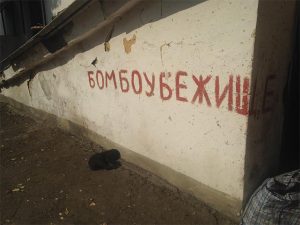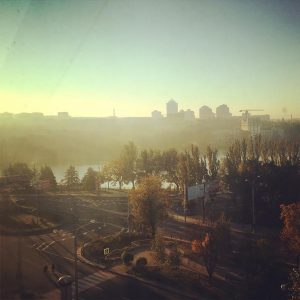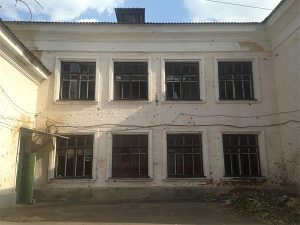“A prayer for the DNR? For victory, huh?” The young boy in a tattered jacket and a monastic hat looks as if he has just stepped out of a film about Ivan the Terrible. He takes a 20-hryvnia bill from a female passenger in the bus travelling to Donetsk. The woman nods shyly. The boy’s eyes shine when he pronounces the words ‘DNR.’
“If you want, I’ll even light a candle for you and say a prayer. That’s worth fifty,” he adds, but the woman refuses and the boy jumps off the bus.
Displaced refugees are starting to return home. The ceasefire signed in Minsk seems to be working, in a way – there are long queues of vehicles on the highway leading to Donetsk. People are slowly returning to the capital of Donbas despite the fact that these roads are periodically being shelled.
For example, a missile sticks out of a crater in the middle of the road to Mariupol, near the ‘DNR’ checkpoint.
Shelling continues here daily, once or twice an hour; explosions can be heard in different parts of the city… sometimes Grads, other times howitzers and mortars.
The epicenters of the war have not changed – the worst-hit areas are situated near the airport and the train station; it is a bit better in Petrovskyi district, bordering with Marinka, where the Ukrainian troops have taken up their positions.
Ten-year Kolia takes me on a tour of the bomb shelter in Petrovsky district.
“This is where my family lives, and we eat here.” He points to a tiny table laden with dishes. “Families prepare meals at home; there’s no gas in the bomb shelter, and then they bring the food down here to the basement. There aren’t any showers or toilets either,” adds Kolia.

“Well, how do you live?” I ask, as I try to understand how anyone could even spend a single day in such conditions.
“You know, people who live close by go to the toilet at home; as for the others… you know very well…in the street,” the boy answers with hesitation.
Kolia has lived in the bomb shelter since July. His family’s home was right in the heart of the shelling; then his family moved to another area, but shelling started there, too. Kolia doesn’t go to school… there is nowhere to go.

The destroyed school lies not far from this bomb shelter. Missiles hit the ceiling of the English classroom. A child’s message – intentional or not – is written in chalk on the blackboard: “Thank you very much! Donetsk, 2014.”
The school principal did not take care of his bomb shelter, so the conditions here are appalling. The basement is cold and damp, old mattresses are spread out on wooden pallets, there is no electricity.
One-year-old Liza is fast asleep, her hands and legs splayed out on one of these mattresses, oblivious to the noise and cold.
While she sleeps, her mother, thirty-year-old Sveta, smokes a cigarette on the street, listening to the volunteers from the Responsible Citizens Group who have just arrived with humanitarian aid.
Svetlana’s partner is a forty-year-old toothless man with dark weathered skin. He worked as a janitor, but was laid off.
“Go to Berdiansk with your kids. At least you can spend the winter there,” the volunteers tell Sveta. Sveta does not think very long, shrugs her shoulders, and replies that it will not be necessary.
She is not registered with her partner. She was taking her passport to the fund commission, but came under fire along the way. She left her home immediately and does not know where her documents are now…. and to hell with them, the documents, she says, at least she’s still alive.
“And what’s in Berdiansk? The ‘Nazis’ are there,” adds Sveta. “I’d rather stay here in Donetsk, it’s safer. And we’ve heard so much about people being slaughtered there, women being raped,” she continues in a grave voice. Aunt Natasha nods her head in agreement.
Aunt Natasha is the oldest resident of the bomb shelter. She is in charge of the humanitarian aid, distributes it, and solves different problems. She used to work as an accountant. Many of her friends are “DNR activists.”

“Yatseniuk looks nasty and repugnant, Avakov’s gay, and as for Poroshenko…” Aunt Natasha spills out everything she knows about politicians.
It takes her just seconds to get going about Kyiv government authorities. She loudly proclaims that ‘Nazi’ commandos regularly come into Petrovka with machine guns and start firing everywhere. Strange to say, but as a rule, the ‘Nazis’ are ‘masked’ and dressed in civilian clothes or in ‘DNR’ uniforms.
A little later I see a group of soldiers dressed in military uniforms of the so-called “Novorossiya army’. They drive by in a vehicle pulling a trailer with a missile launcher. A few minutes later, two shells land in the school yard, exactly where Aunt Natasha had been sitting a few minutes ago.
Some shelters do not have electricity, and lack food and water. Or should I say that there is water up to your knees during the rainy season, but residents have to buy mineral water in the shops, running between the bombardments. One man was killed by a shell on Kyivskyi Prospekt as he was walking towards a shop.
Most residents do not leave the shelters during the day. They venture out for ‘a breath of fresh air’ only late at night when the firing dies down.
‘DNR’ militants, who boasted just a few months ago that they had cleared all the bomb shelters and provided locals with all necessary commodities, no longer show their face in the area.
The people have been left alone to live out a dark and miserable life.
“When it’s quiet, someone will run out and get some hot water,” says an old woman quietly. She is one of the permanent residents of the bomb shelter. Then she gets up and starts shouting, “We’re gonna die here soon! You’ll be carrying our bodies out of here.”
“Yesterday I shared a sandwich with everyone… one sandwich,” adds another elderly woman.
“They (the ‘DNR’) deliver supplies to Voroshilovskyi and Leninskyi districts, where it’s quiet, but here, where bombs keep exploding… there’s no one,” adds the first elderly woman. “Everyone has forgotten us. They say, well, you can come and get help yourselves. Who’s gonna do that, eh…?”
The elderly have been abandoned. They’ve moved to central facilities of destroyed buildings. An elderly woman with diabetes lives in one of the rooms reserved for refugees. Her leg is rotting and she has no help.
Doctors do not get to people like her. Doctors are a real luxury in Donetsk. The medics who have remained in the besieged city generally treat wounded terrorists; they do not have the time or facilities to deal with other people.
Almost everything in Donetsk depends on local volunteers who are not bothered by ‘DNR’ militants. They understand that if the volunteers are not allowed to do their work, civilians will have it much harder.
It is namely the volunteers that travel to cities that are not occupied by the ‘DNR’ and bring back some medicine, food, and hygiene products, all of which are disappearing in Donetsk.

Winter lies ahead, and volunteers are preparing to deliver small stoves to Donetsk. It is unlikely that municipal authorities will have time to repair the heat supply system in the bombed-out areas of the city.
While volunteers are engaged in calculating future expenses, the terrorist leaders of the ‘Donetsk People’s Republic’ and the ‘warlords’ dine in the most expensive cafes of Donetsk. Everybody can see this. There is a real abyss between them and the ‘people,’ for whom they allegedly staged a war.

No one expects anything anymore in Donetsk… either from the parliamentary elections, which will not be held in the area, or from the ‘DNR’ elections – everyone understands that they will be a sham. Neither war nor peace… it seems as if the city has been wrapped in a plastic bag, and all the air has been pumped out… as has the will of all the local residents.
Donetsk has become a ghost town that maintains a semblance of life. The capital of Donbas plunges daily into a deeper coma. How will the city manage to come out of this comatose state? That remains a very big and complicated – and unanswered – question.









